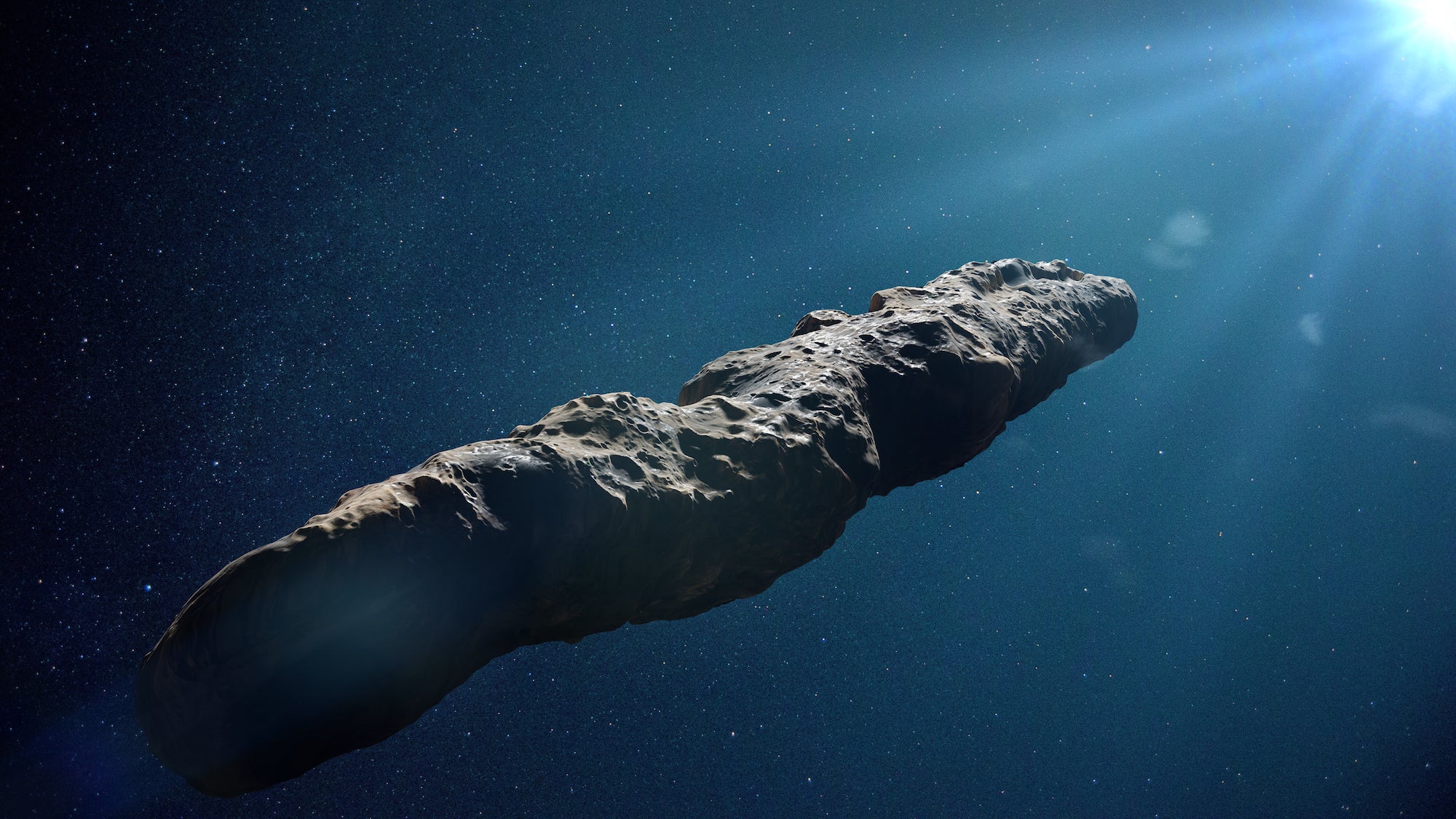
The Oort cloud, postulated in 1950 by the Dutch astronomer Jan Oort, defines the periphery of the solar system—extending out beyond 100,000 times the Earth-sun separation. It contains billions of icy rocks larger than Manhattan Island, as bricks left over from the construction process of the solar system’s planets. The Oort objects on orbits that come close to the sun appear as long-period comets when their ice evaporates by heating from sunlight. One of the large long-period comets may have disintegrated 66 million years ago, producing the Chicxulub impactor that killed the dinosaurs.
The outer boundary of the Oort cloud reaches halfway to the nearest star system, Alpha Centauri. Therefore, if other stars possess Oort clouds similarly to the sun, these clouds touch each other like collections of densely packed billiard balls.
Since the farthest rocks are loosely bound to their parent star, they can be easily dislodged into interstellar space by the gravitational disturbance of a passing star. Such objects will inherit the motion of their parent star relative to the local standard of rest (LSR) because their initial orbital speed around the star is small. It was therefore surprising to find that the first interstellar object discovered, ‘Oumuamua, was nearly at rest in the LSR—given that only one in 500 stars are stationary there.
Despite early attempts to associate ‘Oumuamua with a specific star of origin, it is impractical to do so for interstellar objects because a line of sight in any direction on the sky intercepts numerous Oort clouds which fill up the volume of the Milky Way. Another surprise from ‘Oumuamua’s discovery in 2017 was that the expected abundance of interstellar rocks lost from Oort cloud analogs is too small by orders of magnitude than the value needed to explain the inferred population of ‘Oumuamua-like objects. The nurseries that give birth to ‘Oumuamua-like objects must be different from what we know about the solar system.
Recently, Alan Jackson and Steven Desch suggested that ‘Oumuamua might be a nitrogen iceberg. This represents a rare oddity, never seen before among the numerous bodies within our own Oort cloud. If the first interstellar object ever detected is made of pure nitrogen, that would imply that such nitrogen icebergs are common. Generally, nitrogen is produced together with carbon through the carbon-nitrogen-oxygen, or CNO, cycle in stellar interiors. The Spitzer Space Telescope placed tight limits on the presence of carbon-based molecules near ‘Oumuamua, strengthening constraints from the absence of visual signs of sunlight reflected from a cometary tail. To explain the deviation exhibited by ‘Oumuamua from an orbit shaped by the sun’s gravity, about a tenth of its mass had to evaporate based on momentum conservation. Any nitrogen evaporation would have changed the tumbling period of ‘Oumuamua and caused jitter, well beyond the observed limits. In addition, a nitrogen iceberg would have inherited the motion of its birth star, unlike ‘Oumuamua, which originated in the local standard of rest.
The far reaches of the Oort cloud are not protected from bombardment by interstellar particles. The density of the protective solar wind declines inversely with distance squared, and the wind is stopped by the interstellar medium at a distance that is about 100 times the Earth-sun separation. This stopping boundary, called the heliopause, is still about 1,000 times smaller than the extent of the Oort cloud. In a recent paper I wrote with Merav Opher, James Drake and Gabor Toth, we showed that the heliopause is shaped like a nearly-round, puffy croissant. Outside of it, the Oort cloud objects are exposed to the same environment as interstellar objects are, unprotected from damage to their surface by impacts of energetic cosmic rays, dust or interstellar gas particles.
How did the outer Oort cloud form? One possibility was suggested in a recent paper with my student Amir Siraj, which showed that a temporary twin companion to the sun in its birth star cluster, could have trapped the observed population of outer Oort cloud objects from the cluster environment. This process could also explain the possible existence of distant planets, like the hypothetical Planet Nine.
But an even more striking realization is that most objects within the Oort cloud volume may not be bound to the sun. In another paper with Amir, we showed that the recent discovery of the interstellar comet 2I/Borisov, which most likely originated from an Oort cloud around another star, implies that interstellar objects may outnumber solar system objects within our own Oort cloud. In other words, the Oort cloud objects bound to the sun are swimming in an ocean of background interstellar objects that come and go. Moreover, the discovery of 2I/Borisov implies that about a percent of all the carbon and oxygen in the Milky Way galaxy may be locked in interstellar objects.
Interstellar objects range from dust particles up to the size of planets. Cosmic dust was known to exist in interstellar space for more than a century, supplementing the solar system dust—known from its reflected sunlight, which is observed as zodiacal light. Free-floating planets were identified recently by the Optical Gravitational Lensing Experiment (OGLE), which discovered several such planets through the imprint of their gravitational lensing effect on the brightness of background stars.
Altogether, it appears that the Milky Way is filled with objects, some bound to their parent stars but the majority floating through interstellar space. Studying free-floaters as they cross our backyard in the solar system saves us from the need to visit their birth sites, which would require very long trips. With our existing chemical rockets, it would take about a tenth of the age of the Earth to reach the center of the Milky Way.
Most interestingly, the newly discovered population of interstellar objects enables a search for “bottles” among all the rocks that arrive to the shores of the solar system. These bottles may carry important messages from other civilizations out there. Quoting Immanuel Kant from his book Critique of Pure Reason, “If it were possible to settle by any sort of experience whether there are inhabitants of at least some of the planets that we see, I might well bet everything that I have on it. Hence I say that it is not merely an opinion but a strong belief (on the correctness of which I would wager many advantages in life) that there are also inhabitants of other worlds.”


